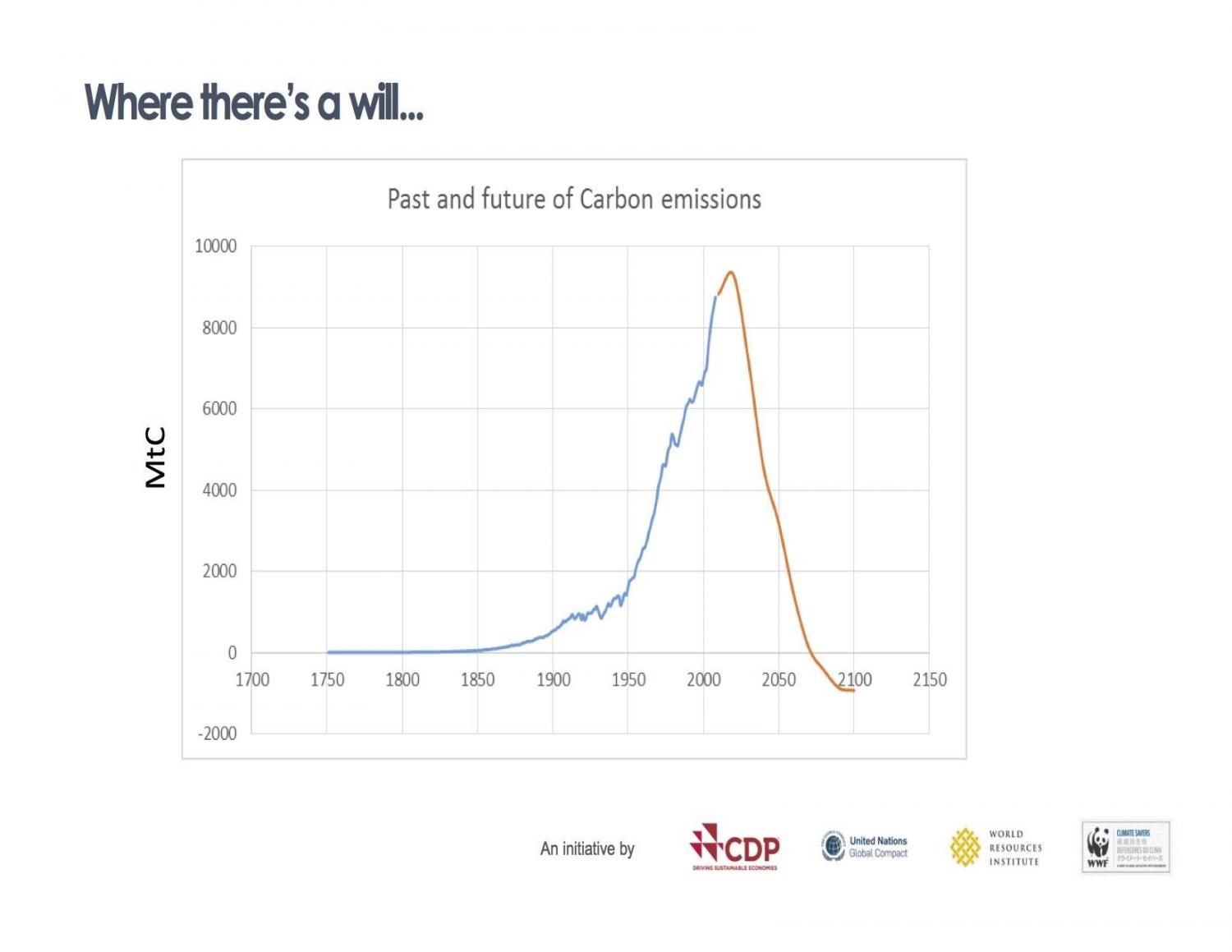
By Joe Madden
A while back, I was fortunate to catch a thought-provoking presentation by Pedro Faria, technical director of CDP (formerly the Carbon Disclosure Project), at the COP21 climate talks in Paris.
He presented the graph below above. At first glance, it appears to depict a “population overshoot scenario” in which a given population exceeds the long-term carrying capacity of its environment, resulting collapse of the population.
But in the case of Faria’s presentation, a closer look reveals that the graph is not a population overshoot scenario – it represents a future scenario in which the human community radically reduces its greenhouse emissions in a manner consistent with science-based GHG targets.
As depicted, we have a very short window to reverse the trajectory of global GHG emissions in order to stay within a “2 degree scenario” – within which we have a reasonable chance of averting catastrophic climate change.
This is a particularly daunting challenge as our planet experienced heat record after heat record in the months since 195 nations signed the now ratified Paris Agreement. Headlines -- and perhaps conventional thinking -- would suggest that the scenario Faria presented is beyond reach.
If one looks closely at Farias graphic, GHG emissions peak before 2030, fall roughly 70 percent below current levels by 2050, are non-existent by approximately 2070, and are significantly negative by 2100. That is somewhat of a “moonshot” when we consider where we are today.
Then again, for most of human history, the moon in the night sky was not considered “reachable.” Then one day, someone imagined that it just might be. Shortly thereafter (in historical terms), the moon was not only within reach, but Neil Armstrong had taken his "giant leap for mankind."
Fast forward from COP21 to the Cleantech Group’s Forum 2017 in San Francisco last week, and --for the first time -- the scenario Faria outlined 14 months prior in Paris did not seem so far off. One could see the physical manifestation of a carbon negative world beginning to emerge.
I had the opportunity to catch up briefly with Robert Niven, co-founder and CEO of CarbonCure. CarbonCure retrofits concrete plants with a technology that recycles waste carbon dioxide to make affordable, greener concrete products. Niven’s approach was simple: more value at a competitive price.
Carbon Engineering, which captures CO2 from ambient air to make fuel, and Lanzatech, which uses proprietary microbes to create chemicals, bioethanol and jet fuel from CO2 waste gases, were also in attendance at the conference.
The proliferation of such companies marks a turning point. Each of these companies, along with others like Newlight Technologies, are leveraging the “carbon cycle” to create the materials that build and power human society. In the case of these products, what is most impressive is the potential for scale. Last year, Newlight signed a 10 billion pound production license with Ikea.
These are not cute products aimed at LOHAS customers. These are the material building blocks of our global society and economy -- concrete, plastics, fuels, steel, etc. -- which pose some of the largest challenges we face in our race to decarbonize. If we can address these areas in scalable, economically viable ways, carbon negativity is indeed possible.
However, for this to happen at the pace required to meet science-based targets, we must accelerate the integration of carbon negative materials into human systems. To do so, we must think systemically about material flows within and across business sectors and borders and then design policy frameworks and information infrastructure to support the systems-based approach necessary to scale these approaches.
If carbon negative materials can be created in these challenging sectors, as the companies noted and others are demonstrating, the key to large-scale adoption is enabling these pioneering companies to unlock the financial value of the carbon stored in their products. This requires the efficient quantification, verification, and transfer of the carbon benefits contained in carbon-negative products downstream to customers, investors and insurers.
More to come on that front....
Image credit: Pedro Faria, CDP
Joe Madden is the co-founder of EOS Climate.
TriplePundit has published articles from over 1000 contributors. If you'd like to be a guest author, please get in touch!














